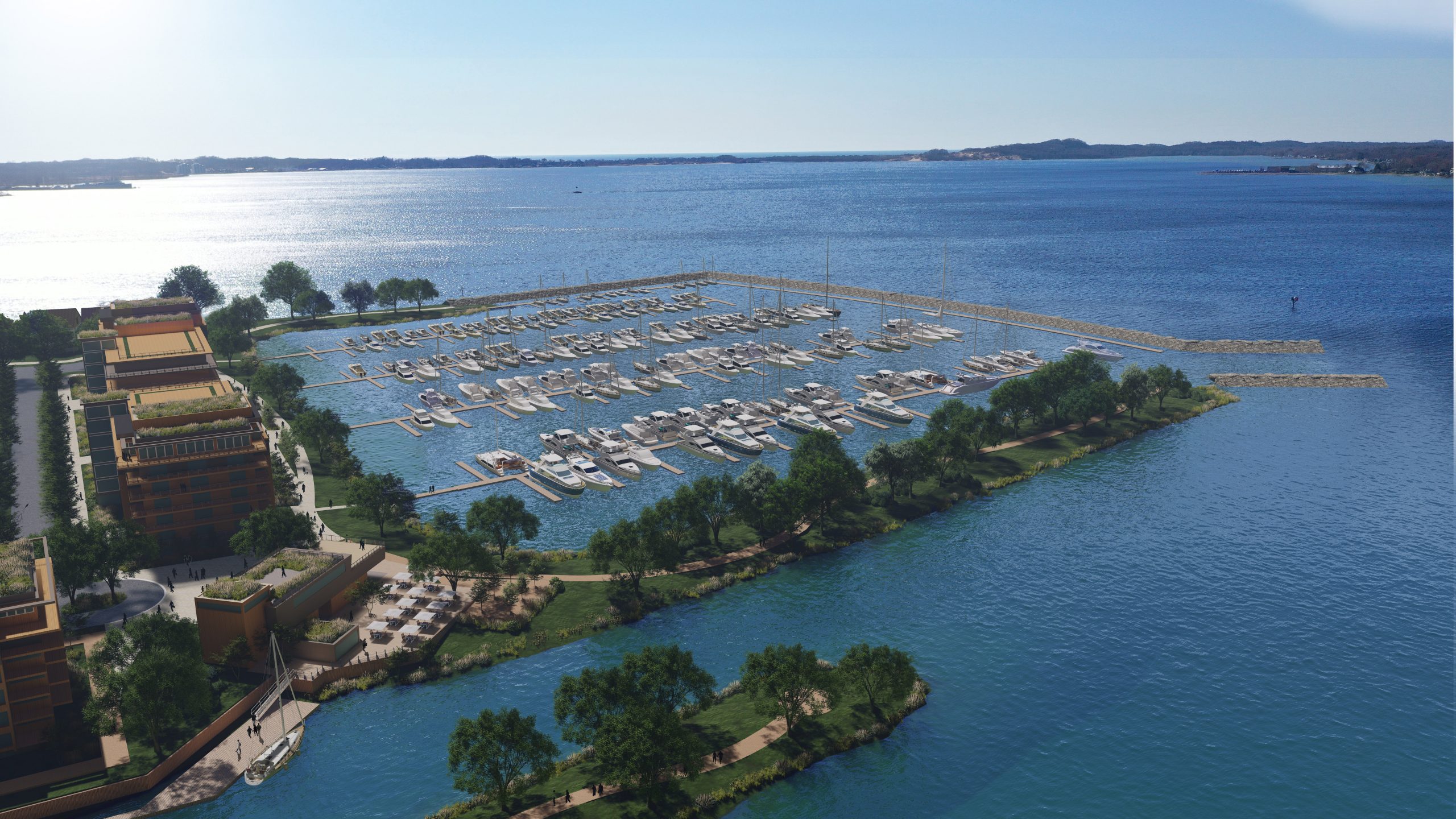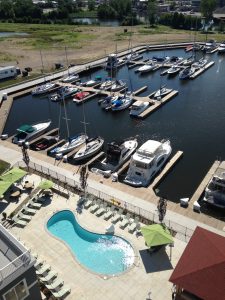
Utilizing Innovation in Sustainable Design to Drive Demand and Profit in a Crowded Market
Published on June 24, 2021Carving out space for a new or renovated marina in a crowded market can be very challenging, especially when so much of what drives marina demand is based on factors somewhat beyond our control, such as location and geography. Since we cannot often move our facilities to a better site – maybe to the other side of that drawbridge? – we need to find ways to differentiate our marinas from the others in the region to attract more customers and charge higher rates.
The Marina at Harbor Shores
One example is The Marina at Harbor Shores in St. Joseph, Michigan. The 68-flip facility is the newest marina in a small town market that is already home to more than 1,100 slips. In order to overcome the challenge of being located upstream of two bridges and competing with several larger and more established marinas, this facility was the first in the market to install floating docks as a key distinction. In addition, the facility integrated the amenities of the adjacent Inn at Harbor Shores including a pool, fitness center, tiki bar, and full hotel services as marina amenities. By setting itself clearly apart from its competitors, this marina has been 100% occupied from the day it opened, at rates at least 10% higher than the competition located closer to Lake Michigan.
Adelaide Pointe
While The Marina at Harbor Shores incorporated more traditional marina amenities to drive demand, the new marina and waterfront development Adelaide Pointe in Muskegon, Michigan is focusing on a more sustainable future to set itself apart. Despite having some of the most beautiful beaches on the shores of Lake Michigan and access to both Lake Michigan and a large inland lake perfect for boating, the City of Muskegon is still working to transition from its historic reputation as an industrial port. While the City will always seek to preserve its mixed-use working waterfront, the Adelaide Pointe project will transform the site of a former steel mill into a model public private partnership that will greatly expand public access to the waterfront through the creation of a new 270 slip marina, 300 new waterfront homes, shops and restaurants, dry stack marina and boat storage, and over half a mile of continuous public waterfront.
The visionary behind the project is Ryan Leestma, a technology and clean energy entrepreneur, lifelong boater, and long-time resident of the community. He has established the keys to the success of this project as achieving the triple bottom line of sustainability, which include environmental, social, and economic sustainability. As the world grows ever more aware of the need to reduce our impacts on the environment, setting an entirely new standard for sustainable design in marinas and waterfront development is already driving intense interest and market demand.
Environmental Sustainability at Adelaide Pointe
The design process of Adelaide Pointe is challenging every assumption to find the most environmentally sustainable and cost-effective strategies. Beginning with the marina basin layout itself, the facility has been organized to orient the slips properly to allow for the smallest possible breakwater structure while maintaining appropriate wave tranquility and safe navigation. The basin design utilized the existing bathymetry to balance the need for dredging with the complementary need for upland fill to mitigate brownfield and floodplain issues while facilitating biofiltration and other stormwater management strategies to protect the water quality of Muskegon Lake.
With the obvious exception of the launch well, essentially all of the 3,500-foot long shoreline will remain open to the public and will incorporate soft shoreline habitat throughout rather than traditional armored shorelines. Inside the marina basin, elevated pile supported boardwalks will provide access to the marina gangways over a soft shoreline preserved through a conservation easement. The stone breakwater itself will incorporate pockets and shelves with appropriately sized stone cobble to support habitat for Centrarchidae fish species, and a continuous public trail system will link the community to the waterfront and extensive fishing access areas. Finally, the marina will be operated under Clean Marina standards to ensure best practices for water quality are implemented.
As the inevitable electrification of the auto industry will also come to boating in the coming years, Adelaide Pointe is going to create as much renewable energy on site as possible through the incorporation of photovoltaic panels on the floating docks and the rooftops of all the buildings on the site.
Supplementing the generation of solar power will be wind turbines incorporated into the marina breakwater. Charging stations for electric vehicles – including boats – will be incorporated throughout. In order to reduce overall energy demand, the facility will utilize the latest LED lighting systems and “dark sky” lighting strategies to reduce the overall lighting demand for the site. Dark Sky lighting strategies reduce the need for lighting by reducing light pollution and points of glare, which allows for much greater visual acuity, safer navigation, and less impact on migratory bird species – all while saving energy costs. Many other energy saving strategies will be added, including individual monitoring of electricity use at each slip, and use of electric boat handling equipment wherever practical.
Moving upland, the mixed-use structures will utilize Mass Timber construction techniques, which both greatly reduce embodied energy in the buildings and reduce costs, but also recall the history of Muskegon’s past as a major center of the lumber industry. Atop these structures will be green roofs to further manage stormwater and reduce heat island effects while creating native habitat for pollinator species.
Social Sustainability at Adelaide Pointe

The idea behind social sustainability is recognizing the impact of private development on the surrounding community. Social sustainability is achieved by expanding access to the waterfront for everyone, regardless of age, income, or physical abilities, while also minimizing potential negative impacts. Adelaide Pointe is making every inch of the waterfront accessible and open to the public and surrounding neighborhoods, with the exception of areas where safety is a concern, such as the launch well facilities and the secured seasonal floating docks. Access to the water itself will be provided through ADA compliant fishing overlooks and paddlecraft access sites. Just as important, Adelaide Pointe will offer a boat club as well as boat, PWC, and paddlecraft rentals, so nearly everyone can afford to find a way to get out on the water – and someday maybe become boat owners themselves.
The construction of the project will utilize many local and Michigan based businesses, and the project will create hundreds of jobs over the short and long term.
Economic Sustainability at Adelaide Pointe
There are less expensive ways to build a marina and waterfront project like Adelaide Pointe, but the economic benefits of doing the right thing for the environment and community far outweigh the costs when considered in total. Operational and energy expenses will be lower, as will overall development costs when the life cycle costs of more durable materials are considered for example.
From a development perspective, the uncertainty of permitting and local entitlements can be very costly and time consuming. By taking the time early in the planning process to develop the plan with environmental and social sustainability in mind, the support of local environmental groups and positive reactions from the community and City Commission has already been gained, which we believe will result in fewer project delays in permitting approvals and allow the project to come to market much sooner than a traditional approach.
Equally important, there are many grant funding opportunities available that focus on sustainable design strategies and public access, including support for renewable energy systems, habitat creation, clean water stormwater management, public access, and transient boating that will reduce overall development costs. As the site is a brownfield, Adelaide Pointe will also be partnering with the City of Muskegon to utilize brownfield Tax Increment Financing to offset the cost of cleanup and construction of non-revenue generating infrastructure.
The positive reaction to this different approach to waterfront development has been overwhelming from the boating and homebuyer community, which has resulted in the upland development components being moved up on the schedule from 2026 to breaking ground next spring. From the investor perspective, all of this results in lower risk and faster returns and a greater likelihood of success for Adelaide Pointe.
Northside Marina Renovation
While it is easier to implement system wide strategies in the construction of a new facility, nearly all of these strategies can be incorporated into the incremental renovation of existing marinas in one form or another. The recent renovation of Northside Marina in South Haven, Michigan after extensive high water flood damage incorporated the use of Kebony, a very durable and renewable alternative to more exotic hardwoods. The project also utilized as much of the existing structures as possible to minimize costs and environmental impacts, and the entire electrical system was updated to reduce energy demand and improve safety. Ultimately, sustainable design strategies can help improve the environment, the community, and the bottom line.
| Categories | |
| Tags |




